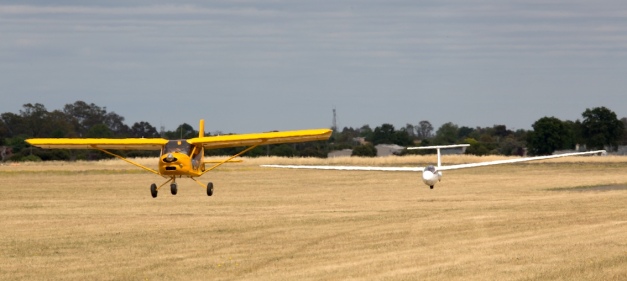The Foxbat is used successfully in several countries as a glider tug and was recently tested in both Australia and New Zealand to find out just how capable the aircraft might be for this purpose.
Below is a synopsis of the New Zealand experience and a link to a video covering the Australian testing. The NZ Foxbat was a standard 100hp Rotax 912ULS powered A22LS fitted with a KievProp series 283 (71″ diameter) propeller and a Tost glider release hook. The Australian aircraft was identical, except that we used the 68″ WarpDrive propeller with tapered tips, which customers more commonly order for best cruise.
[As a short aside, after the respective towing experiences, we tested the two different propellers, to establish which would give the best static thrust for glider towing. In simple terms, at the same maximum throttle 5,700rpm engine speed, the WarpDrive tapered tips prop gave around 135kgs static thrust and the KievProp 283 series around 185kgs – close to 50% more static thrust. It is thus pretty conclusive which prop would give the best performance for glider towing, if not outright cruise speed.]
The tug pilot in New Zealand was Ian Williams, who has over 30 years’ experience of towing gliders. He says that depending on glider weight, the Foxbat was towing up to 2,000 feet at times between 6 and 9 minutes, from wheels off to wheels landing. This is just about the same total time as heavier GA tug aircraft, times which are also borne out by Australian tow times. What the Foxbat may lose in outright climb, it easily regains in descent, where the liquid cooled Rotax engine helps protect from shock-cooling.
With similar tow times to typical GA tugs, the Foxbat offers some useful additional advantages:
– it is much more economical on fuel and maintenance, burning well under half the fuel per tow
– it is much quieter, an important factor where residential housing is encroaching on airfields
– in an emergency, the Foxbat, being much lighter and more manoeuvrable than its GA counterparts, should be able to recover from unusual attitudes very quickly
Overall, in both New Zealand and Australia it was felt that the Foxbat could handle 75-80% of glider towing required by clubs, with only heavy, water-laden single seaters and some heavier two seat gliders outside the flight envelope. In Australia, it was noted that high-tow resulted in much better performance than the more common and preferred low-tow technique.
For Australian information, here’s a link to a short video of Foxbat glider towing at Benalla, with the Gliding Club of Victoria in Australia. Chief tug pilot Mark gives the commentary.
If you want to try out a Foxbat for glider towing at your club, please contact:
– in Australia, Peter Harlow at Foxbat Australia – +61 413 900 892
– in New Zealand, Doug King at LiteFlight Green – +64 210 285 6932


Having carried out quite a few aero tows in the Foxbat with varying glider types,.. plus have “trialled” a number of GA aircraft for glider towing, there is one point I would like to emphasize. Modern composite gliders are surprisingly heavy and with critical airfoil design have quite specific towing speeds. Usually because of the relative position of the tow hook being the point of “thrust” (if there was an engine there) For example the VNE of a duo Discus is around 140Kts but the max towing speed is 95 Kts …. it towed at higher speeds the Duo becomes quite unstable.
A similar situation at the low speed end. While the normal stall speed is quite low, the minimum towing speed is in excess of 65 Kts.
When towing, the important issue is that speed is more important than altitude (except if there are objects in the way)
I found that when towing a big heavy glider like a Duo Discus, the time taken to accelerate in excess of 65 Kts in the Foxbat was surprisingly high. The prob was the Foxbat was already flying when the Duo was still firmly on the ground so it needed to be “held down” just above the ground to accelerate to 65 Kts plus. The best rate of climb speed of the Foxbat was a lot lower than the accepted towing speed for the glider. This is a serious issue to consider
Towing much lighter gliders is not a problem of course.
A Club in New Zealand uses a turbo Dynamic (Rotax 914) with a C/S Woodcomp prop. this combination is working well. The Prop has a controller which presets the max engine RPM. On take off with full throttle a small trigger below the throttle will increase the boost pressure to 40 inches. Once established in a climb, the trigger is released and throttle reduced to 30 inches for the rest of the climb. The best rate of climb speed of the Dynamic is much closer to the desired glider towing speed.
Maybe a A32 with a 914 turbo would work.
Thanks for your comments Ian. The A22LS we used was fitted with an Airmaster electric c/s propeller, set to 5800 rpm (full power) for take off and 5500 rpm for climb. The tow pilot found that occasional bursts of 5800 rpm on the climb helped the 2-seater. It is also customary in Australia to use the ‘low tow’ configuration, which (I am told) is safer but not as efficient as the ‘high tow’ configuration predominantly used in other countries. Thanks again for your valued comments.